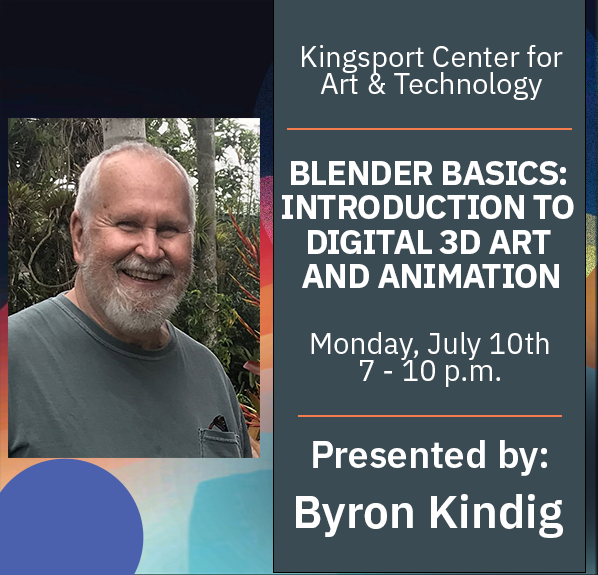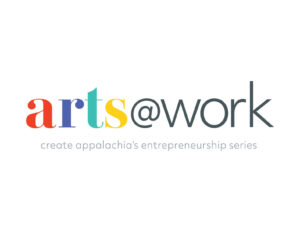

Instructor: Byron R. Kindig
Non-Member Fee: $375 per person
Paid Member Fee: $300 per person
Create Appalachia’s Kingsport Center for Art and Technology (KCAAT)
225 W Center Street, Kingsport, TN 37660
More and more employers are looking for Blender on resumes. Join us to add this important software package to your toolbox! Blender is a powerful 3D Modeling and Animation suite that can be obtained at www.blender.org for free. Blender is a program for artists, created and developed by artists and programmers. This in-person class will offer students the opportunity to ask questions and receive specific and immediate feedback from the instructor. (Scroll down to the bottom to see the topics to be covered in the class.)
This in-person, interactive 8-week class series will allow you to ask questions in real time and get immediate help with your projects from an expert. Byron Kindig, our instructor, has been teaching Blender for the past 16 years. He has been published in Blender Artist Magazine, issue #21. He has also organized the Kingsport International Digital Art Show, years 1, 2 and 3, and has organized 2 Tri-Cities Blender Conferences. He is a founding member of the Tri-Cities Blender Users’ Group.
Over the class sessions, students will gain insight into how to use the many different elements of Blender, including:
The Blender Graphical User Interface (GUI) The Blender Graphical User Interface is extremely efficient and practical. In the beginning of this class students will be introduced to what the various types of windows are for, what the icons and symbols mean, and how to set up Blender to fit their own preferences and work flow. Students will also be given a file containing default settings for use in this class, so that everyone is working with the same setup.
3D Mesh Modeling Most 3D objects students will be creating and working with in Blender are Mesh Objects. These mesh objects can be as simple as a plane or as complex as a fully modeled human figure. Background images can be used as guides in different views such as front and/or side. During this class students will learn techniques for creating just about any object imaginable
Materials & Texturing Once the Mesh Objects are created, materials will be created and added to this to give it color and texture. Blender’s Materials tools are also quite robust. Users can add simple color to an object, as well as adjust the Opacity/Transparency, Specularity, Roughness (shininess), Metalicity, etc.
Textures add additional detail to your material such as variations in color, the way light reflects, on the surface, the roughness of the surface and even variations in transparency.
In Blender, textures can be procedural as well as image based (drawn, painted, or photographic.) Textures can even be videos. In Blender, these textures can be applied in several different ways including UV mapping. The Mesh Object is cut, unwrapped and flattened to a plane much like a map of the globe. This map is then painted or photo cloned and then rewrapped. Students will also paint directly on their mesh object on their monitor, rotating it with the mouse to see and paint all sides.
Animations Blender has a great number of tools for making objects in your scene move. Simple animation of an object’s position, size, and rotation is covered early on in the class. Blender allows key frames to be set and then computes what the in between frames should look like. This is known as “tweening.” Simple animation covers not only location, rotation, and scale of objects, but also just about every other characteristic an object can have such as color, transparency, texture.
More complex animation, such as deformations in characters limbs and facial expressions are done with Armatures and Shape Keys. Armatures are analogous to bones. The bones are parented to the character mesh and each bone’s influence on the character mesh is painted onto the part of the body it controls. The armature is then animated using Key Frames to create movement. Shape Keys are analogous to muscles and are used to control the changes that occur in a mesh such as a face smiling or eyes blinking.
Lighting In Blender, lamps, can be added as needed. There are lamps that have parallel rays like the sun or an overall light like the sky, spot lights that can be adjusted for the angle of their cone of illumination and the fuzziness of the edge of their circle of light. There are lights that only cast shadows with out illuminating an object, or don’t cast shadows. The brightness of these lights and their color can be adjusted and animated. Lights can be textured with a procedural texture, an image or even a movie. 360 HDRI images can also be used to light scenes in Blender.
Particles Particle systems allow for the creation of many interesting effects, from sparks, snow, and rain, to swarms of animated objects. Particles can render or be place markers to copy other objects to. For example, a simple butterfly can be modeled and parented to a particle system that copies the one butterfly into a large number of butterflies. These can be affected by forces like wind, gravity, or by interactions with each other like a flock of birds. Hair, fur, and grass can be created using the particle system as well as painting instances of flowers, rocks or plants in a landscape. These can be set to vary enough so that no 2 are alike.
Curves Curve objects can be rendering or non rendering, or used as guides for other objects. Curves can be used to deform mesh objects or as paths for objects to move along during an animation. Curves are good for creating wires, cables, strings, vines, that you want to be able to move smoothly or grow.
The cost is $300 for members. It’s $375 for non-members and those with free community memberships. All profits from this class will be reinvested in the Arts@Work Series.
Create Appalachia , a 501 (c) 3 non-profit, strives to makeour region a better place to live and work by supporting innovation and entrepreneurship centered around the arts and creativity. We work to sustain an environment that will generate new businesses, provide jobs in arts-based businesses, and highlight the important role that creativity plays in the region’s economic vitality.
The Arts@Work Series supports entrepreneurial creatives and makers who wish to develop their professional business skills. Topics include introductions to business strategy, marketing, communication, pricing, and client relations. The Arts@Work professional development series is curated to meet the particular needs of small creative businesses that combine artistry, imagination, and technology.
Instructor Bio:
Byron Kindig has been teaching Blender for the past 16 years. He has been published in Blender Artist Magazine issue #21. He has also organized Kingsport International Digital Art Show, years 1, 2 and 3, and has organized 2 Tri-Cities Blender Conferences. He is a founding member of the Tri-Cities Blender Users’ Group.
